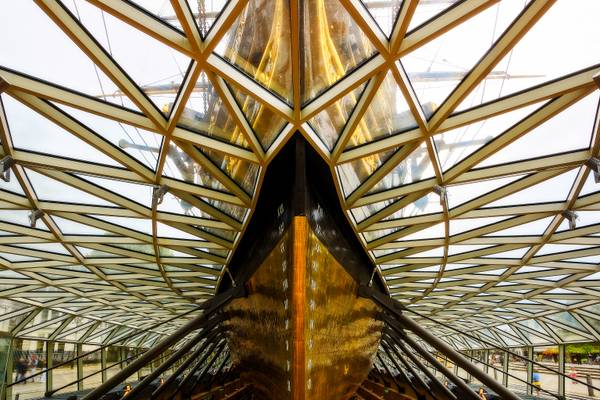United Kingdom » London »
The Keel of the Cutty Sark

0
About 50-years ago, I built a model of a sailing ship called the Cutty Sark. At the time, I tried to find out as much as I could about this ship, but this was a time before worldwide access to the “everything” as we have now… I learned some, one of those things being that it was one of the fastest wind-driven ships ever built. However, I had no idea the ship still existed.
In our recent trip to England, my wife Joyce and I pored over the "worldwide everything" to make decisions as to what we might like to see. One of my contributions was to visit the Royal Observatory in Greenwich. While studying on that, I found out that the Cutty Sark not only still existed, but it was also a museum dedicated to the Age of Tea Clippers that sent England all over the globe... and it was within walking distance of the observatory.
Tea is not merely a commodity in the United Kingdom, it’s a tradition… and the Cutty Sark had a hold large enough to import an incredible amount of tradition! On her first round trip voyage, she sailed from London in February of 1870 with a cargo of wine, spirits, and beer bound for Shanghai. She returned to London nearly eight months later in October, carrying 1,305,812 pounds of tea from Shanghai… like I said, a lot of tradition.
At the time it was built, the Cutty Sark was the fastest clipper on the seas, with a top speed of a little over 20 mph. In the days of masted ships, that was moving! As it was with any sailing ship, however, speed is dependent on both wind and the constant ability of the ship’s complement of sailors to tack the ship efficiently by adjusting the sails to the conditions… over her years of service, Cutty Sark averaged a little over 15 mph, which is still remarkable, especially when you consider that this ship plied over a million miles of ocean over its lifetime. While Cutty Sark more than paid for itself in what it carried from port to port, it was surpassed by the same issues we know of today… new technology. At nearly the same time it first came into service, steam power was being applied to ships. Ships with steam engines were no longer at the mercy of wind and current, and even early models were faster than the Cutty Sark.
I fully expected to find the Cutty Sark in the water off the Greenwich Pier, so I was quite surprised to see it displayed in this way. As you can see, it’s open at the top, braced to handle the ravages of gravity on a structure that was intended to float in the water, and with a fascinating assembly that seals in everything from the keel down… it’s almost like you’re peering up at the ship from under water. If that wasn’t the intent, they missed a major point! What was most odd to me was to think of the ocean depths that passed under this keel… yet, a few minutes after this shot, we each enjoyed a cup of tea while sitting under the rudder that steered it to those depths.
One thing I never figured out in the days before the internet and that was just what “Cutty Sark” means. It comes from Scottish poet Robert Burns’ narrative poem, Tam o’ Shanter. In the poem, farmer Tam goes on drunken tirades, and like many a person who goes on drunken tirades, he sees things such as witches dancing. Upon seeing a particularly immodest witch, he shouts, “Weel done, cutty-sark!” So, now you know. What’s that you say… you still don’t know? Me neither. I can tell you, however, that “Weel” is the same as ‘well’, and that “cutty-sark” means ‘short-shirt’. In other words, the witch was dancing topless. I suppose it could have referred to the ship before it unfurled its sails... your guess is as good as mine at this point. The figurehead for this ship is the witch in the aforementioned condition... I didn't point the camera that high to keep things in perspective. Needless to say, she probably holds the world's record for the breaststroke.
